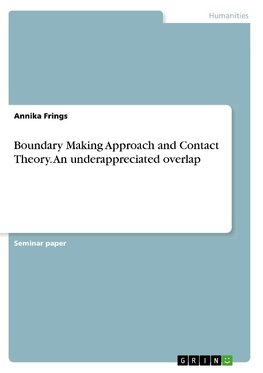
-
 Anglický jazyk
Anglický jazyk
Boundary Making Approach and Contact Theory. An underappreciated overlap
Autor: Annika Frings
Seminar paper from the year 2016 in the subject Sociology - Political Sociology, Majorities, Minorities, grade: 1,3, University of Cologne (Soziologie und Sozialpsychologie), language: English, abstract: Until now, there has been a huge body of literature... Viac o knihe
Na objednávku, dodanie 2-4 týždne
14.76 €
bežná cena: 16.40 €
O knihe
Seminar paper from the year 2016 in the subject Sociology - Political Sociology, Majorities, Minorities, grade: 1,3, University of Cologne (Soziologie und Sozialpsychologie), language: English, abstract: Until now, there has been a huge body of literature either discussing the importance of various boundary making strategies or the meaning of intergroup contact in changing relations between in- and outgroup members. However, I argue that there is a great overlap between both approaches, describing similar phenomena, but giving them different notations. I aim at describing the importance, contact between different groups can have on making, changing or reinforcing the boundaries between them and furthermore, try to prove the existing, but underappreciated overlap between boundary-making approach and contact theory.
To understand those processes, it is first of all significant to give a proper definition regarding the meaning of symbolic and social boundaries. I therefore refer to the commonly cited definition of Lamont and Molnár (2002), who describe symbolic boundaries as means to categorize objects or people into different groups and create memberships. They can, if there is a consensus about them, be transformed into social boundaries, making them a necessary condition of the latter. Contrary, social boundaries can be described as manifested differences, which limit social opportunities and lead to inequality in the access of material and nonmaterial resources for different individuals and groups. Boundaries can be drawn based on various characteristics and in different fields. A broad range of previous literature has discussed boundaries drawn based on racial, moral, cultural and socioeconomic factors, thus distinguishing between ethnic, moral cultural and class boundaries, whose existence could be proved in various countries. For instance, Sachweh (2013) utilized quantitative survey data and conducted qualitative interviews, to analyse the types of symbolic boundaries present in the German society. He found evidence for the existence of moral, socioeconomic and cultural boundaries drawn by different groups. The same is true for the study of Lamont (1992), comparing symbolic boundaries drawn by upper middle class men in France and the USA, demonstrating the varying importance across countries. Lamont and Molnar (2002) have also shown that boundaries are meaningful in different research fields, discussing examples of research in e.g. gender inequality, social and collective identity, professions and science or national identities.
- Vydavateľstvo: GRIN Verlag
- Rok vydania: 2018
- Formát: Paperback
- Rozmer: 210 x 148 mm
- Jazyk: Anglický jazyk
- ISBN: 9783668785670







 Nemecký jazyk
Nemecký jazyk 
 Ruský jazyk
Ruský jazyk 



